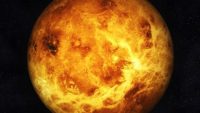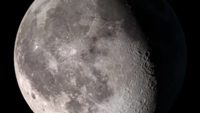By Dr. Danny R. Faulkner Flat-earth proponents aim to demote gravity as a force, but they fail to account for time-honored conventions in physics informed by relativity. …read more Source: AIG Daily
By Dr. Danny R. Faulkner An overview of the light travel time problem, how different biblical creationists have addressed it, and the dasha solution to the problem …read more Source: AIG Daily
An interesting article1 on physics.org caught my attention. Its title is “Solved: The Mystery of the Expansion of the Universe.” But this can be misleading. The material covered really does not solve the problem of how the universe purportedly came to be expanding in the first place.2 However, it does attempt to solve a computational difference between two different methods of calculating an important number in c… More… …read more Source: icr.org
Scientists led by Valerio Poggiali of Cornell University’s Center for Astrophysics and Planetary Science have used Cassini spacecraft data to learn a little more about Saturn’s largest moon Titan. They analyzed radar data obtained by the Cassini spacecraft to infer that Titan’s largest sea, the Kraken Mare, is at least 1,000 feet deep.1 However, unlike seas on Earth, this sea is mostly methane with s… More… …read more Source: icr.org
By Ken Ham It was only five months ago that headlines declared life had been discovered on Venus. The articles associated with the headlines were slightly more nuanced—signatures of life may have been discovered on the hot little planet second from the Sun. Only a month after, two separate studies argued with those conclusions, saying the “signature of life” (phosphine) wasn’t found in Venus. Well, now another study says phosphine was not found on Venus (saying it was sulfur dioxide). Amazing what five months can do! But because not finding evidence of life on Venus is not considered sensational, this [More]
By Dr. Danny R. Faulkner The solar system supposedly formed gradually from the collapse of a cloud of gas and dust. Obviously, this idea is at odds with the biblical creation narrative. …read more Source: AIG Daily
By Dr. Danny R. Faulkner Geoffrey and Margaret Burbidge played a key role in slowing the acceptance of dark matter. Therein lies a cautionary tale for scientists. …read more Source: AIG Daily
By Dr. Danny R. Faulkner SETI experiment suggests non-natural radio signal coming from the vicinity of Proxima Centauri, but it seems to be another failed attempt to find alien life. …read more Source: AIG Daily
By Dr. Danny R. Faulkner Hopefully, 2021 will see the demise of COVID-19 and the many restrictions prompted by concerns about its spread, and so perhaps we soon can get back to normal. …read more Source: AIG Daily
A team from the Massachusetts Institute of Technology (MIT) used NASA’s Transiting Exoplanet Survey Satellite (TESS) to discover a gas giant in another solar system. The planet holds a new record for being a hot Jupiter-like exoplanet with the shortest year.1 Designated TOI-2109b, the planet takes just 16 hours to orbit its host star, as opposed to the earlier record-holder, which orbited its host star in 18 hours… More… …read more Source: icr.org
By Dr. Danny R. Faulkner An explanation of the December solstice, an overview of its celebration in pagan cultures, and a potential Christmas Star on December 21. …read more Source: AIG Daily
Despite the latest failure to detect dark matter, why do they continue searching? …read more Source: creation.com
By Ken Ham God created the universe mature. Instead of giving just an appearance of age, God created it fully functional, according to the Bible. …read more Source: AIG Daily
The James Webb space telescope will be able to examine the atmospheres of exoplanets in greater clarity than ever before. Will we find a truly habitable exoplanet? …read more Source: creation.com
By Ken Ham An astronomical phenomenon that will happen early in the evening on December 21 is quickly gaining worldwide attention in the media. This conjunction of Jupiter and Saturn—when the two planets will appear to be very close to each other from our earthly perspective—has been labeled by some as a “rare Christmas star,” and, due to its appearance in a few days before Christmas . . . well, you can see why the idea is getting so much attention! Our astronomer, Dr. Danny Faulkner, shared his thoughts on this planetary conjunction (and how you can view it!): This [More]
By Dr. Danny R. Faulkner The very inaccurate manner with which flat-earthers handle the Coriolis effect and the Foucault pendulum is typical of those in the flat-earth movement. …read more Source: AIG Daily
An exoplanet 260 light-years away is being described as the first of its kind ever detected.1,2 This exoplanet, catalogued as LTT 9779b, is called an “ultra-hot Neptune” because of its large size and nearness to its host star. This exoplanet is so close that its surface temperature is over 1700° Celsius, and the length of its year—the time it takes to orbit its star—is just 19 hours! Astronomers think the pl… More… …read more Source: icr.org
By Dr. Danny R. Faulkner Using a modified Boeing 747 equipped with infrared instruments, NASA discovered small amounts of water on the moon. What does that mean for biblical creation? …read more Source: AIG Daily
Well, there goes another star, disappearing into the night as if it had never existed. For an entire year, Hubble scientists used the space telescope to record snapshots of SN 2018gv—a supernova (SN) or exploded star. Experts then edited those images into a NASA video showing the fast fading of the supernova.1 It’s hard not to wonder, given the astronomical number of stars in the night sky, why we witness more stars fade th… More… …read more Source: icr.org
By Dr. Danny R. Faulkner Astronomers have attempted to identify exoplanets likely to support life though their efforts have generated scant results so far. …read more Source: AIG Daily
What should we think about phosphine in Venus’s clouds? Why do all living creatures use phosphate? …read more Source:
Secular scientists are obsessed with attempting to show that life on Earth is not unique and therefore must exist, if not elsewhere in our solar system then somewhere in our Milky Way Galaxy. It is this worldview that resulted in the fruitless, decades-old project called the Search for Extraterrestrial Intelligence (SETI). It began with much anticipation and fanfare, but today has yet to reveal life or intelligent signals beyond Earth.More… …read more Source: icr.org
By Dr. Danny R. Faulkner Another SSSB (asteroid or comet) discovery suggests the existence of the Oort cloud or Kuiper belt . . . or does it? …read more Source: AIG Daily
By Dr. Danny R. Faulkner Does the Bible teach or demand geocentrism? Hardly. Does good science indicate that the earth is motionless? Certainly not. Then why do some Christians believe otherwise? …read more Source: AIG Daily
By Dr. Danny R. Faulkner What is geocentric theory and a brief history, arguments for/against, how it relates to the flat earth movement & what the Bible says about geocentrism. …read more Source: AIG Daily
This summer, the Hubble Space Telescope took a brilliant new photograph of Saturn and its rings.1 Saturn’s moons Mimas and Enceladus can also be seen in the photo. For a number of years now, the Hubble Space Telescope has been taking yearly photographs of Saturn at about the time that Earth is closest to the planet, about 840 million miles away. This is part of an effort to obtain a sequence of images in order to study the atmosp… More… …read more Source: icr.org










































